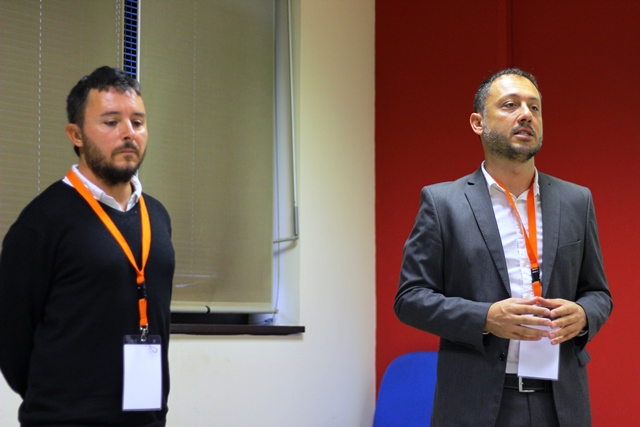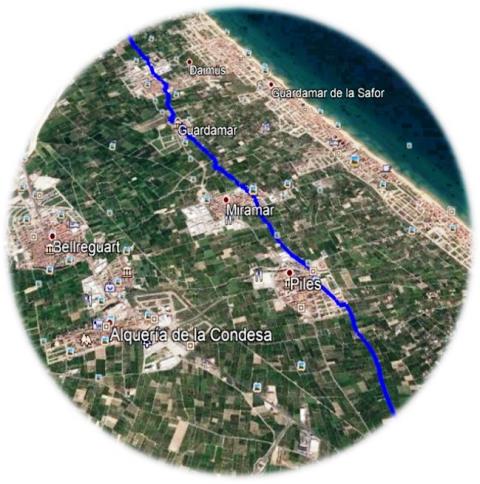Recover our forgotten heritage and create a project to improve and preserve it for future generations, while creating a tourist route to diversify the offerings of la Safor. These are the objectives of the Final Degree Project “Proposal for the Development and Enhancement of the Vía Augusta Branch in the Towns of Oliva, Piles, Miramar, Guardamar and Daimús in the Safor County”, carried out by Francesc Romà Torres Bataller, graduated in Tourism from the Universitat Politècnica de València (Campus Gandia) under the supervision of UPV professor Pau Pérez. The final degree project obtained an Excellent Cum Laude.

Francesc Romà Torres Bataller and Pau Pérez
The proposed project extends from the town of Oliva to the mouth of the Serpis River and promotes sustainable cultural and recreational tourism. The work describes the cultural and landscape resources of the existing heritage, designs the route and adds value a road that in use since the first century, that passes through the towns of Piles, Miramar, Guardamar and Daimús.
“The premise of this project came about with the help of my father, Román Torres Climent, and his love and experiences collected on this road, coinciding with the general lack of awareness about its value, beyond its role as a back road leading to the orchards and marenys (marshes) used by the inhabitants of the villages it connects. I’d like this project to prompt for the local agents from the area to work together on tourism, since they’re not in the habit of doing so, despite sharing the same beach and marshland,” says Francesc Romà Torres.
During development of the project, the creators worked with the paradigm of cooperation between the towns involved, since they all have common geological elements such as natural sources (ullals), civil architecture, unique flora, native fauna and unique landscapes.
To interpret the viability of the route, open-ended interviews were conducted with the local politicians and with technical personnel from the respective tourism departments. “We have dud field work to analyze the route and see the intersections, distances between sign placements, points of interest to place interpretive panels, travel times. In addition, we inspected tourist resources of interest along the route, as well as proposals for improvement.
According to the graduate in Tourism, it is a perfectly applicable product and after interviewing the local agents in charge, he observed a newfound predisposition to work together if the product is economically beneficial to the municipalities.
DESEASONALIZING TOURISM
According to Francesc Romà Torres, the localities of Oliva, Piles, Miramar, Guardamar and Daimús are mature sun and beach tourist destination that face important challenges with regard to deseasonalizing the demand, that tend to concentrate in the summer months and school holidays,” explains the expert.

Additionally, there are strong indications that the measures to deseasonalize the demand are working. “Since 2012 the average hotel occupancy from the months of March to October has constantly risen by 12% until 2017, according to INE data. These statistic substantiate the commitment to creating a cultural, gastronomic and family-oriented offer that can be consumed 365 days a year. We must also recognize the efforts of the private sector, which keeps tourism business open for twelve months and demonstrates that the businesses committed to staying open year-round are reaping their rewards,” says the expert in Tourism.
Even so, in the four towns that the Via Augusta passes through, Daimús, Guardamar, Miramar and Piles, located between the two main cities of the southern half of the Safor, Gandia and Oliva, the tourist products that are offered are even more seasonal and limited to good weather and summer, according to Francesc Romà Torres.
PRODUCT CHARACTERISTICS
The product designed, called “Via Augusta Branch”, due to the importance and constant nature of commercial activity since the Roman era, includes six natural sources (ullals), along a route that spans 7.5 kilometers. It also runs through a geological fault that provide a privileged access to the marjal (marshlands) that allow the visitor to enjoy the channels and the unique flora of the landscape.

The route includes trapiches (medieval sugarmills), though according to Francesc, the towns of Miramar, Guardamar and Daimús only conserve the external architectural structures, that would have to be marked with explanatory panels to bring to light the important role they played in sugar production in the XV- XVI centuries, contributing to the cultural explosion of the county during this time period. The route offers visits to houses, streets and farmhouses from eras “that have to be preserved and rediscovered”, states Francesc.
The product proposes complementary visits to the tower of Piles, as well as the Joan Pellicer Bataller bicyecle route, “which run perpendicular to our route and are of high cultural and natural interest,” the expert points out.
The most significant profiles for this demand, according to the turismologist, would be cultural and educational, “The former because they are passionate about culture and historical information in general and the latter because I think that educational activities could be offered aimed at rediscovering present and past resources,” says the expert. Also bicycle touring, since the route and landscape are perfectly suited to this kind of activity.
Communication and Marketing Officer, Campus Gandia.











